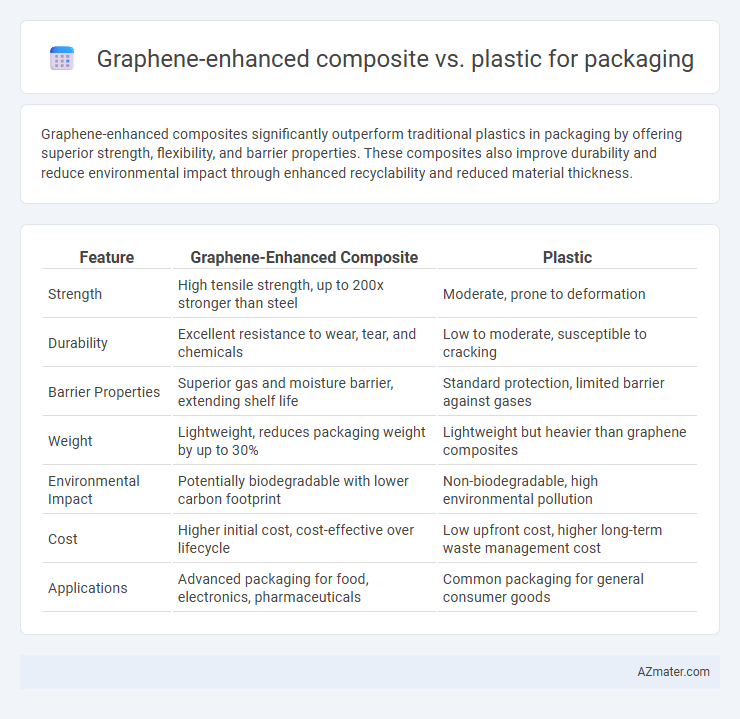Graphene-enhanced composites significantly outperform traditional plastics in packaging by offering superior strength, flexibility, and barrier properties. These composites also improve durability and reduce environmental impact through enhanced recyclability and reduced material thickness.
Table of Comparison
| Feature | Graphene-Enhanced Composite | Plastic |
|---|---|---|
| Strength | High tensile strength, up to 200x stronger than steel | Moderate, prone to deformation |
| Durability | Excellent resistance to wear, tear, and chemicals | Low to moderate, susceptible to cracking |
| Barrier Properties | Superior gas and moisture barrier, extending shelf life | Standard protection, limited barrier against gases |
| Weight | Lightweight, reduces packaging weight by up to 30% | Lightweight but heavier than graphene composites |
| Environmental Impact | Potentially biodegradable with lower carbon footprint | Non-biodegradable, high environmental pollution |
| Cost | Higher initial cost, cost-effective over lifecycle | Low upfront cost, higher long-term waste management cost |
| Applications | Advanced packaging for food, electronics, pharmaceuticals | Common packaging for general consumer goods |
Introduction to Advanced Packaging Materials
Graphene-enhanced composites offer superior mechanical strength, thermal conductivity, and barrier properties compared to traditional plastics, making them ideal for advanced packaging applications. These materials significantly improve packaging durability, extend shelf life by preventing gas and moisture infiltration, and reduce environmental impact due to their enhanced recyclability and reduced material thickness. Innovations in graphene-integrated composites are transforming the packaging industry by enabling lightweight, high-performance solutions that meet increasing consumer and regulatory demands for sustainability and functionality.
Overview of Graphene-Enhanced Composites
Graphene-enhanced composites combine graphene's exceptional mechanical strength, thermal conductivity, and barrier properties with traditional polymer matrices to create superior packaging materials. These composites exhibit significantly improved durability, flexibility, and resistance to gas and moisture permeation compared to conventional plastics, extending product shelf life and reducing spoilage. Advances in scalable graphene production and composite processing technologies continue to enhance the cost-effectiveness and performance of graphene-based packaging solutions.
Plastic Packaging: Properties and Limitations
Plastic packaging offers lightweight, cost-effective, and versatile solutions with excellent moisture resistance and ease of thermoforming, making it widely used in food and consumer goods industries. However, plastics suffer from limited mechanical strength, poor barrier properties against gases and UV light, and environmental concerns due to low biodegradability and recycling challenges. These limitations often result in reduced shelf life for packaged products and contribute to increasing plastic waste pollution.
Mechanical Strength Comparison
Graphene-enhanced composites exhibit significantly higher mechanical strength compared to traditional plastics, offering improved tensile strength, impact resistance, and durability. These composites demonstrate up to 50% greater fracture toughness and enhanced stiffness, making them ideal for robust packaging applications. Their superior mechanical properties ensure better protection and longer lifespan of packaged goods under mechanical stress.
Barrier Properties: Moisture and Gas Resistance
Graphene-enhanced composites exhibit superior barrier properties compared to traditional plastics, significantly reducing moisture permeability and gas transmission rates. The atomic thickness and dense lattice structure of graphene create an impermeable layer that effectively blocks oxygen and water vapor, extending packaging shelf life and preserving product freshness. This enhanced resistance to moisture and gases makes graphene composites an ideal material for advanced food packaging and sensitive electronic components.
Environmental Impact and Sustainability
Graphene-enhanced composites offer significant environmental advantages over conventional plastics by improving material strength and reducing the need for excessive packaging, leading to lower resource consumption and waste generation. These composites are often more durable and recyclable, contributing to a circular economy and decreasing landfill accumulation compared to traditional plastics that persist for centuries. Their biodegradability and potential to reduce carbon footprint make graphene-enhanced composites a promising sustainable alternative in packaging industries striving for eco-friendly solutions.
Cost Analysis: Production and Scalability
Graphene-enhanced composites offer superior mechanical strength and barrier properties compared to traditional plastics, but currently entail higher production costs due to expensive raw materials and complex manufacturing processes. Scalability challenges arise from limited large-scale graphene production techniques, which restrict cost efficiency gains in packaging applications. Plastic materials remain more cost-effective for mass production, yet ongoing advancements in graphene synthesis and composite fabrication are expected to progressively reduce expenses and enable competitive scalability.
Safety and Regulatory Considerations
Graphene-enhanced composites offer superior barrier properties and mechanical strength compared to conventional plastics, reducing contamination risks in food and pharmaceutical packaging while complying with stringent FDA and EU regulations. Their enhanced antimicrobial and thermal resistance capabilities address safety concerns, making them suitable for sensitive and perishable goods. Regulatory frameworks are evolving to assess nanomaterial migration and toxicity, with graphene composites undergoing rigorous testing to ensure consumer safety and environmental compliance.
Innovations in Packaging Design
Graphene-enhanced composites revolutionize packaging design by significantly improving mechanical strength, barrier properties, and thermal stability compared to conventional plastics. These innovative materials enable thinner, lighter packaging solutions that extend shelf life and reduce environmental impact due to graphene's exceptional conductivity and durability. Integrating graphene into composites facilitates smart packaging designs with enhanced functionality such as improved gas and moisture resistance, offering superior protection for perishable goods.
Future Trends and Market Outlook
Graphene-enhanced composites are set to revolutionize packaging by offering superior strength, flexibility, and barrier properties compared to traditional plastics, driving demand in industries prioritizing sustainability and durability. Market forecasts predict a compound annual growth rate (CAGR) exceeding 20% for graphene composites due to increasing regulatory pressures against single-use plastics and rising consumer preference for eco-friendly packaging solutions. Innovations in scalable graphene production and cost reduction will accelerate adoption, positioning graphene-enhanced materials as a key player in the future packaging market landscape.

Infographic: Graphene-enhanced composite vs Plastic for Packaging
 azmater.com
azmater.com